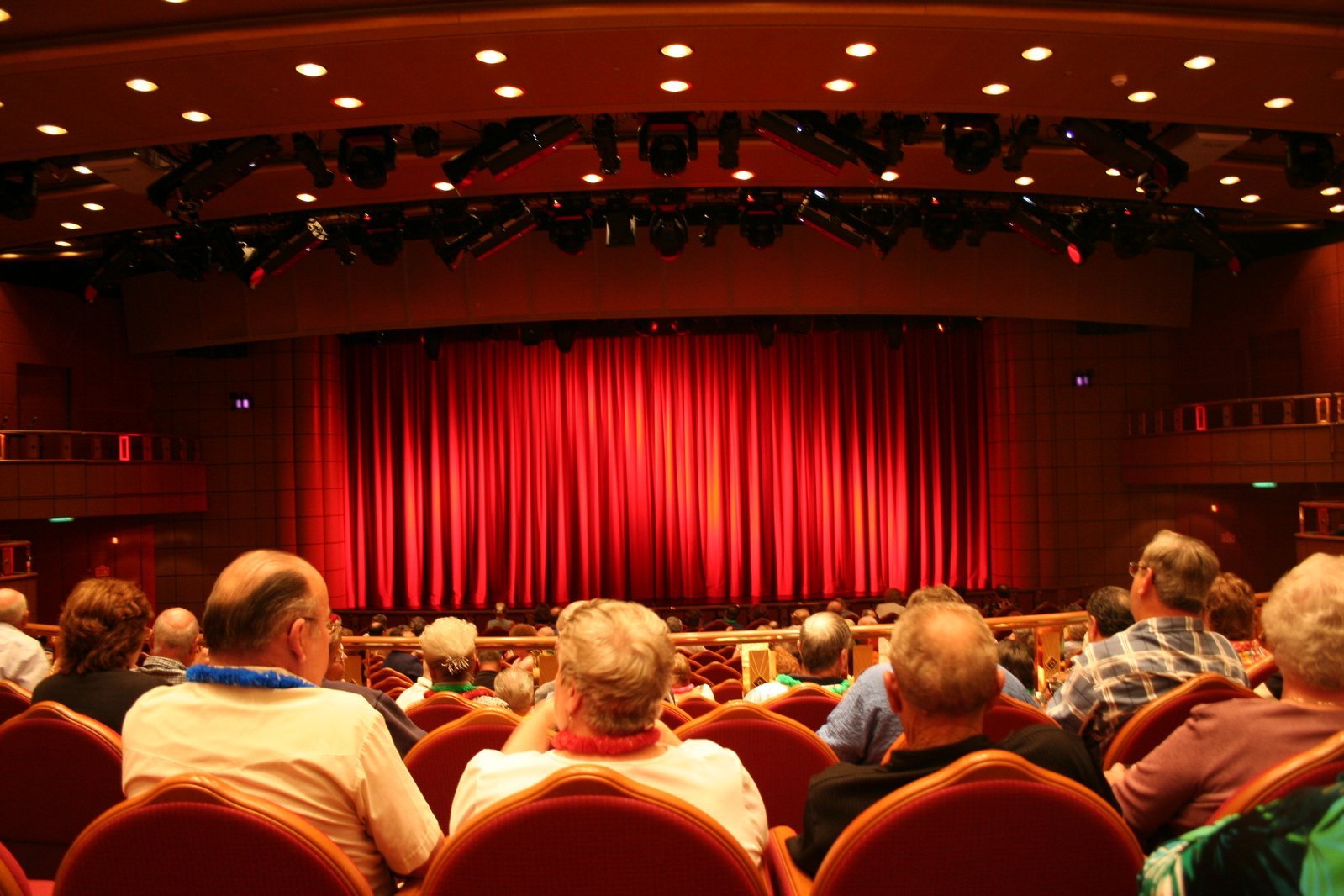
A snapshot of older audiences
What are the characteristics, interests and motivations of the over-65 demographic? Lucie Fitton reveals all.
The Audience Agency’s Audience Finder compares data from over 800 cultural organisations across the UK, representing 30% of households in the context of broader population figures and datasets. By combining this large dataset with decades of arts research and engagement experience, we can draw a confident picture of how certain groups do or don’t engage with arts and cultural experiences.
Exploring the arts engagement of over 65-year-olds, in comparison with younger audiences, reveals distinct differences in behaviour, taste and motivation. ‘Elders’ represent a significant and growing proportion of existing and potential UK audiences, with population projections suggesting that almost a quarter of people will be above retirement age by 2030.
Learning and intellectual stimulation are the strongest motivations once audiences pass 75
This is an evolving and varied group – considerations such as mobility and family situation vary considerably between someone recently retired and a 90-year-old. Recognising the nuances in this age bracket is key, so where possible we show how different age groups within the over-65 age range engage distinctly.
We look at who older arts and cultural audiences are, what their characteristics as visitors are, how they may engage differently with different artforms and what motivates them. We know that these stats are only part of the story, however, and have included thoughts on good engagement practice and links to inspirational examples and complementary research.
Different motivations
To be entertained is not a surprising motivation for engaging with arts and culture for any cohort. All age groups are looking to be entertained and have fun, but this factor is more pronounced for the over 65s, with over a third saying it is their main driver. Learning and being intellectually stimulated are also popular drivers, especially for museums and heritage offers.
The picture gets more interesting when you delve into the different age groups within the elders bracket. Learning and intellectual stimulation are the strongest motivations once audiences pass 75. There are some clear steers here for reaching out to older audiences. It is important to pay attention to these nuances and cater for the appetite for straightforward entertainment as distinct from learning and self-improvement opportunities.
The same people may be looking for different experiences on different occasions. Explicit invitations to learn and explore through specially devised activities, participation programmes or volunteering have been very effective in building a strong community of older people around an organisation. Particularly successful examples include University of the Third Age and the Arts Society. Older audiences also say that their cultural life is an important part of their identity, which may in part account for why programmes that put older people in a position of leadership are particularly impactful.
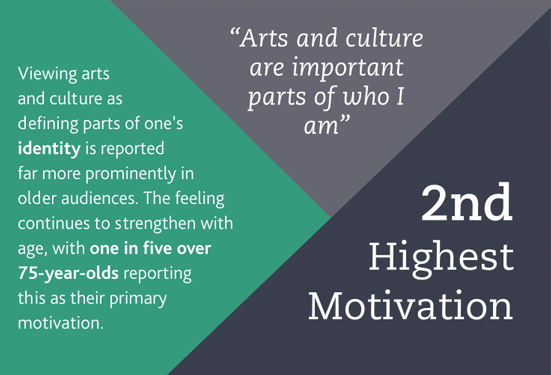
Loyal visitors and strong advocates
It’s not just an assumption: the over-65s are demonstrably the most organisation-loyal and frequent arts engagers. 58% visit the same venue multiple times a year – much higher than for under-65s. Recognising this loyalty is a win–win, with traditional membership schemes and benefits being noticeably more popular with older audiences, to the advantage of both the organisation and the older community it is serving.
The data shows that older audiences are more likely to be visiting as part of larger, extended family groups than as the sole responsible adult
Older audiences are also the most likely group to rate their experience as positive and endorse you to their friends and family. 82% of over 65s rate their likelihood to recommend their visit as 9 out of 10 or higher. We talk a lot about the concept of ambassadorship for younger audiences, but there is so much potential to engage older arts and culture enthusiasts as advocates for your organisation.
Ambassador opportunities for older people can fulfil many needs, not just by maximising their goodwill and inclination to celebrate your venue or site, but also by providing valuable and much desired learning and social experiences for your elder audiences. There have been many inspirational examples in recent years – Manchester’s Valuing Older People’s Culture Champions scheme and Royal Exchange Theatre’s Elders Company to name but two – that have yielded positive widespread social results.
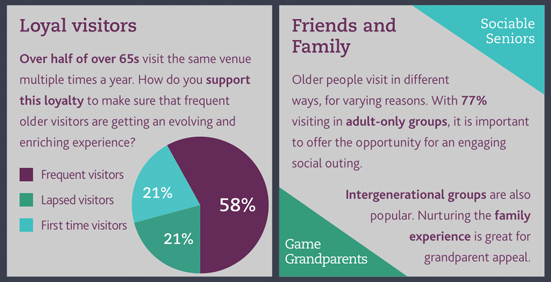
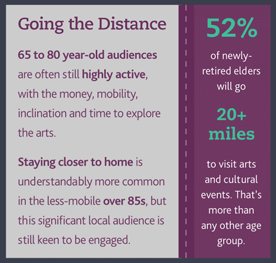
Sociable seniors and game grandparents
77% of those surveyed aged over 65 visit as part of an adult group, so they are certainly a social bunch and need to be catered for as such. How is your offer – from the programme itself, to activities, to retail, to catering and beyond – constructed to engage adult group visits? Could you build or develop your participatory or interactive opportunities to engender more of an atmosphere for a social day out with friends?
Moreover, as families become ever more richly varied, considering how to engage multi-generational audiences is more important than ever. Those aged between 65 and 69 are twice as likely as the over-85s to be visiting in a mixed adult and child group: a distinct younger elders cohort of active and engaged grandparents with the means and will to engage in family activities.
The data shows that older audiences are more likely to be visiting as part of larger, extended family groups than as the sole responsible adult – useful to know when planning family activities. How can family members across three or four generations be similarly stimulated and engaged in the visit?
In the Engagement Snapshot we share a short case study about SHIFT, an arts project that successfully supported intergenerational learning and engagement through digital approaches. This is a growing area of opportunity for older audiences who are seeking to develop digital skills and confidence, a prospect that could be particularly well received in environments they are already comfortable in.
Accessing specific audiences
Access is always important to consider with audiences aged 65 and over, who are unsurprisingly more likely to be limited a little by health or a long-term condition or disability – 15% versus just 6% for audiences aged under 65. Interestingly, the data shows that similar levels of under- and over-65s audiences identify as being limited a lot by a health or long-term condition.
This said, what we don’t directly see in survey response data is the vastly greater number of older people whose impairments currently entirely prevent them from engaging at all in, and therefore feeding back on, arts and cultural activities. Who are these audiences? How do you find, engage and serve them? An Engagement Area Profile Report can help answer these questions.
There is a huge amount of research and work that shows the potential of arts and culture to engage and be shaped by new audiences and older people, many of whom may be experiencing access challenges and social isolation. Studies by The Baring Foundation, Centre for Better Aging and Age UK are shared in the Engagement Snapshot as great starter-for-ten research. The Arts Council England-funded Celebrating Age Programme and Age of Creativity festival provide a plethora of further inspiration and networking opportunities.
Audience data shows that elders engaging in arts and culture are less ethnically diverse than under-65s. Whilst local population data (found in our Area Profile Reports mentioned above) can tell you what the local demographics are (not just limited to ethnicity) and what the gaps may be between those who are and aren’t engaging, it is still important to consider distinct needs and interests of specific older people.
Experience has taught us that older people are especially motivated to take part in cultural activities that they feel capture their community’s cultural traditions and experiences, share them and pass them on in some way. Similarly, elders who have experienced discrimination or unfair treatment (and perhaps been part of movements to challenge this) are often strongly motivated by projects where they have a chance to capture their community’s experience of discrimination, chart their struggles and campaigns, mark milestones and ground won.
The older the audience, the more change they are likely to have experienced, and arts and culture programmes that capture and reflect this sense of pride and progress are well received.
Challenging stereotypes
It’s easy to make assumptions about the types of arts and culture that older people are keen or even able to engage with. Audience Finder data shows the broad Elders cohort to be far more significantly represented in performing arts than visual arts audiences. With visual arts – here meaning contemporary galleries, rather than museums or heritage attractions – comes the opportunity to consider how older people can be better engaged in less traditional artforms. As with other audiences, one highly effective strategy is to feature art, artists and stories that reflect and represent the group you are seeking to attract within your programming.
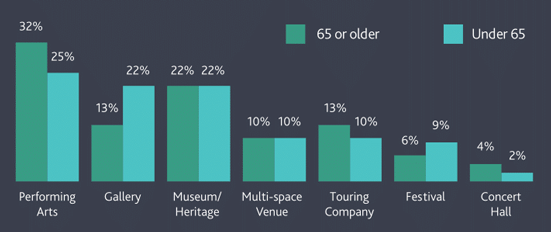
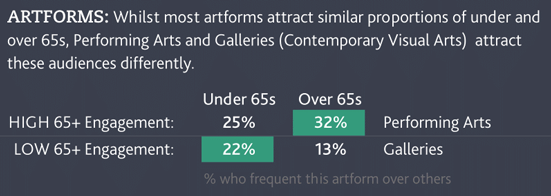
We recently supported the evaluation of Southbank Centre’s (B)old Festival, a demonstration that age is no barrier to producing cutting-edge, though-provoking art and performance. It’s important to be mindful of the risk of pigeonholing elder arts into stereotypical forms: older artists can produce work that is just as relevant and innovative as that of any other artist. During our evaluation, one performer’s words particularly stood out: “[It] empowers young people to realise their world doesn’t close down at a certain age. They see that they can keep performing.”
Arts produced by and with older people can explore stories across the range of human experience, and that is something people of all ages and walks of life can relate to. It’s vital to support artists and other facilitators working with older audiences to understand how to work best in participatory settings.
Our report on the Age Gap Symposium, hosted by Older People’s Arts Network, explores in some detail the importance of supporting facilitators to develop a more sophisticated understanding of ageing and access to peer support and training opportunities.
Delving into the data
One in five people in England is over the age of 65, and the figure is growing. This is a large and diverse cohort ranging from recently retired people to great-grandparents. Delving into the data about older audiences can help the artistic sector think practically about the role we can play in building a fulfilling creative culture for them. Have a scroll through the full Older Audiences Engagement Snapshot to kick-start considering your own strategies.
Lucie Fitton is Head of Learning and Participation at The Audience Agency.
www.theaudienceagency.org
Read the full Engagement Snapshot on older audiences. The Audience Agency will be releasing other specialised Engagement Snapshots over the coming months, covering family, younger and disabled audiences and local communities. Please send your feedback about this Engagement Snapshot to [email protected].
This article, sponsored and contributed by The Audience Agency, is part of a series sharing insights into the audiences for arts and culture.
Join the Discussion
You must be logged in to post a comment.